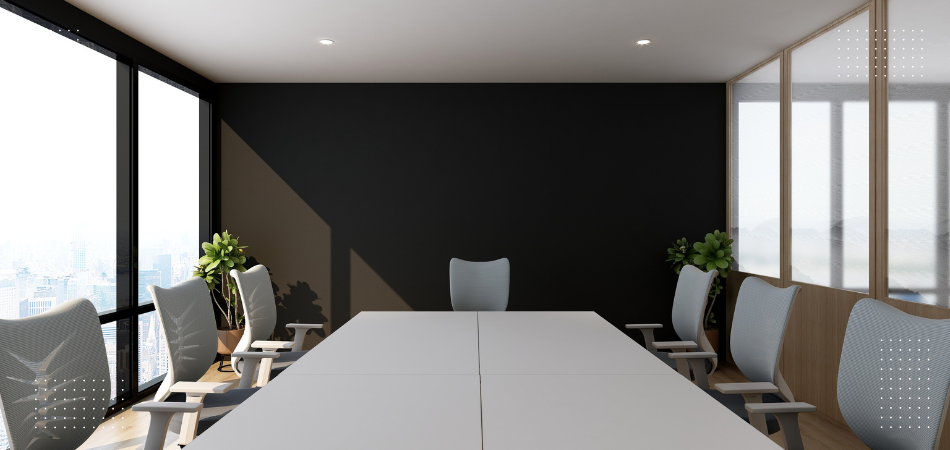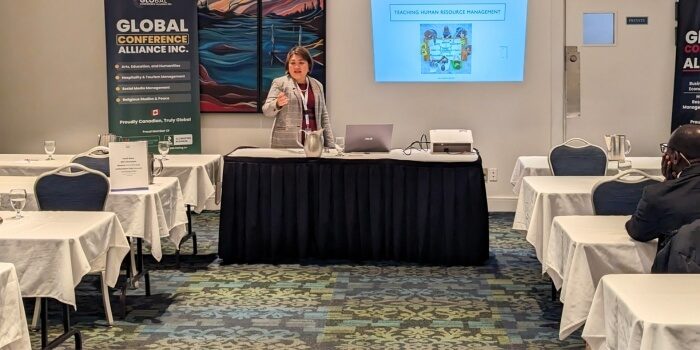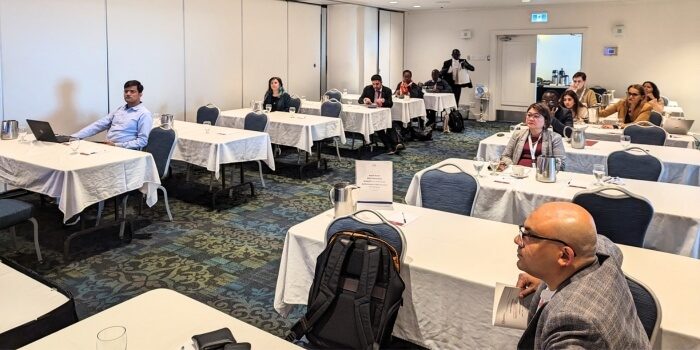A quiet and secluded space can be crucial for maintaining focus and productivity when conducting meetings, conferences, or presentations. However, many conference rooms are not designed to be soundproof, which can lead to distracting noises from outside or neighboring rooms. In such cases, it becomes necessary to soundproof the conference room to eliminate unwanted noise and ensure privacy. But the question is, how to soundproof a conference room?
Soundproofing a conference room can involve various techniques and solutions, from simple do-it-yourself methods to professional soundproofing options. You can create an environment conducive to effective communication and collaboration by assessing your soundproofing needs and understanding the available techniques.
This article will explore some of the most effective ways to soundproof a conference room, including DIY solutions, professional soundproofing options, and tips for maintaining and improving the acoustics of your space.
Understanding Soundproofing Basics
To soundproof a conference room effectively, it’s essential to grasp the basics of sound transmission and absorption, along with the different types of sounds that can disrupt your meetings. Let’s break this down into simple terms.
Sound Transmission and Absorption
First off, sound transmission is all about how sound waves travel through the air and various materials. When an object vibrates—like a person speaking or music playing—it creates sound waves that spread out. These waves can bounce off surfaces or pass through walls and ceilings.
When sound waves hit a surface, several things can happen.
Reflection: Some sound waves bounce back, creating echoes and making the room feel noisy.
Absorption: Other waves are soaked up by materials, which helps reduce noise. Think of soft items like carpets, curtains, and acoustic panels; they absorb sound waves and keep the noise levels down.
Transmission: If sound waves aren’t reflected or absorbed, they pass right through the material, leading to noise issues in adjoining rooms. For an effective soundproofing conference room, our goal is to maximize absorption and minimize transmission. This often means using a mix of materials to build barriers that sound can’t easily penetrate.
Airborne VS Impact Noise
Next, let’s talk about the two main types of sound: airborne noise and impact noise. Understanding these will help you tackle the noise challenges in your conference room.
Airborne Noise: This type travels through the air as sound waves, like voices, music, or traffic outside. Airborne noise is usually the primary concern in conference rooms. When people are talking, giving presentations, or having discussions, their voices can carry and disrupt the flow of your meeting. To manage this, you can use sound-absorbing materials such as acoustic panels and thick curtains. These help to soften the sounds and create a more focused environment.
Impact Noise: This noise comes from physical actions, like footsteps on a hard floor or furniture being moved. Impact noise can be trickier to deal with since it travels through solid materials. For example, if someone drags a chair across the floor, that sound can echo throughout the building. To combat impact noise, consider adding carpets or rugs, which can absorb sound and prevent it from traveling. Soft furnishings also help, creating a more welcoming atmosphere while keeping noise levels in check.
By understanding these basics of sound transmission and the different types of sound, you’ll be well-equipped to choose the right materials and techniques to create a quiet, comfortable conference room. This knowledge makes it easier to transform your space into a haven of productivity.
How To Soundproof A Conference Room?
Soundproofing a conference room is essential for creating a focused and productive environment. Whether you’re trying to block out distracting noises from outside or minimize internal echoes, following these steps can help you achieve a quieter space. Let’s dive into the process that will tell you the secret of how to soundproof a conference room.
Step 1: Assess Your Conference Room
Start by identifying the sources of noise that disrupt your meetings. This could include traffic sounds from outside, chatter from nearby offices, or echoes bouncing off hard surfaces in the room. Walk around the conference room at different times of the day to listen for various distractions, noting which areas are most affected. Understanding these noise sources will guide your soundproofing efforts, allowing you to target specific problems effectively.
Step 2: Choose the Right Materials
Gather the appropriate soundproofing materials that fit your needs and budget. Here are some effective options.
Acoustic Panels: These are specially designed to absorb sound waves and reduce echoes in a room. They come in various styles, colors, and designs, allowing you to choose options that match your conference room’s decor while improving acoustics.
Soundproofing Foam: This lightweight material is great for absorbing sound. It can be easily applied to walls and ceilings, helping to dampen noise and improve the overall sound quality in the room.
Mass Loaded Vinyl (MLV): A heavy, flexible material, MLV is effective at blocking sound transmission. It can be installed on walls or ceilings to create a barrier against external noise.
Weatherstripping: This material is ideal for sealing gaps around doors and windows. It’s an affordable solution to prevent sound leakage and keep external noises at bay.
Step 3: Insulate Walls and Ceilings
If you’re able to make structural changes, consider adding insulation to the walls and ceiling. This can involve installing soundproof drywall, which contains sound-absorbing materials, or adding insulation batts to the wall cavities. For rooms where structural modifications aren’t feasible, mounting acoustic panels or foam directly onto existing walls can enhance sound absorption and reduce echo. Choosing the best color for a conference room will help you to decorate the walls and ceilings perfectly.

Step 4: Address the Floors

Carpeting: If your conference room has hard flooring (like tile or wood), adding carpets can significantly reduce noise. Carpets absorb sound and prevent it from bouncing off hard surfaces, creating a quieter environment.
Area Rugs: If you prefer not to carpet the entire room, using thick area rugs strategically can also help absorb sound and provide a cozy feel. They can be placed under tables or in areas where team members gather.
Step 5: Improve Windows and Doors
Windows and doors can be major sources of noise leakage, so it’s essential to address these areas.
Double-Glazed Windows: If your budget allows, consider upgrading to double-glazed windows. They provide better insulation against sound, making it harder for outside noises to penetrate.
Weatherstripping: Installing weatherstripping around the edges of doors and windows creates a tight seal, blocking noise from sneaking in. This simple step can dramatically reduce external sounds.
Door Sweeps: Adding door sweeps at the bottom of doors can help seal the gap between the door and the floor, further reducing noise from hallways or adjacent rooms.
Step 6: Add Soft Furnishings
Incorporating soft furnishings can help absorb sound and make the space feel more inviting.
Cushioned Chairs: Choose upholstered chairs instead of hard, reflective seating. Soft materials absorb sound, making conversations easier and quieter.
Bookshelves: Strategically placing bookshelves filled with books can act as natural sound barriers. They add character to the room while helping to absorb noise.
Plants: Adding plants not only beautifies the space but also contributes to sound absorption. They can soften the acoustics and create a calming environment.
Step 7: Utilize Technology
Consider using sound masking systems that emit a soft background noise to help mask disruptive sounds. This gentle noise can make conversations more comfortable and reduce the perception of outside noise. Additionally, invest in quality microphones and speakers to enhance audio clarity during meetings. Good audio equipment ensures that everyone can hear and be heard without straining, further improving the meeting experience.
Step 8: Test Your Soundproofing
After implementing these soundproofing measures, it’s time to test the effectiveness. Conduct a few meetings and pay attention to any persistent noise issues. Gather feedback from team members about the acoustics and whether they notice any improvements. If necessary, make adjustments or add more sound-absorbing materials until you achieve the desired level of quiet.
Step 9: Budget-Friendly DIY Solutions
If you’re on a tight budget, there are several DIY options available to enhance soundproofing.
Create Your Acoustic Panels: You can make panels using fabric-covered foam boards. These can be hung on the walls to absorb sound, adding both functionality and style.
Repurpose Furniture: Utilize existing furniture, such as sofas or cushions, to help absorb sound. Rearranging furniture can also create a more inviting atmosphere.
Hang Tapestries: Hanging thick tapestries or quilts on the walls can provide sound-absorbing qualities while adding a decorative touch to the room.
Soundproofing a conference room might seem like a daunting task, but by following these steps, you can create a quiet and comfortable environment for meetings. A well-soundproofed space enhances focus, boosts productivity, and encourages open communication.
What Are the Benefits of Soundproofing a Conference Room?
Soundproofing a conference room is not just about keeping noise at bay; it’s about creating an environment that fosters productivity, creativity, and effective communication. Let’s explore some key benefits of soundproofing your conference room and how it can positively impact your meetings.
Enhanced Focus and Concentration
One of the most significant benefits of soundproofing is the ability to maintain focus during meetings. In a noisy environment, it’s easy for distractions to creep in—whether it’s traffic sounds from outside, chatter from nearby offices, or echoes bouncing off hard surfaces. By reducing these distractions, participants can concentrate better on discussions, presentations, and brainstorming sessions. This heightened focus can lead to more productive meetings and a greater exchange of ideas.
Improved Communication
Effective communication is the cornerstone of successful teamwork. Soundproofing helps ensure that everyone can hear and be heard clearly, reducing the chances of miscommunication. When voices are muffled or drowned out by background noise, important points can get lost in the shuffle. A well-soundproofed room allows for clearer dialogue, encouraging team members to share their thoughts openly and confidently. This not only enhances collaboration but also strengthens team relationships.
Professional Atmosphere
A soundproofed conference room conveys professionalism and attention to detail. When clients, partners, or stakeholders enter a quiet and serene environment, it sends a message that your organization values quality and cares about creating a conducive space for discussions. Playing soft music related to the event theme can be a good addition, provided that you know about the right music selection for conferences. A calm atmosphere sets the tone for productive conversations, leaving a lasting impression on visitors. It shows that you’re committed to conducting business in a focused and respectful manner.
Increased Privacy
Privacy is crucial for sensitive discussions, whether it’s negotiating contracts, discussing client information, or planning strategies. Soundproofing helps create a safe space where confidential conversations can take place without the worry of eavesdropping. This is especially important in open-office layouts or shared spaces where sound can easily travel. By ensuring that sensitive information remains private, soundproofing builds trust among team members and clients alike.
Better Audio Quality
If your conference room is equipped with audio-visual technology, soundproofing can significantly improve audio quality. Background noise can interfere with presentations, video conferences, and conference calls, making it difficult for participants to hear each other. By reducing external noise, soundproofing enhances the clarity of audio, allowing everyone to participate fully without straining to hear. This leads to smoother meetings and more engaging discussions.
Enhanced Employee Well-Being
A noisy work environment can contribute to stress and fatigue among employees. By creating a soundproof conference room, you’re providing a space where employees can escape the hustle and bustle of the office and focus on their work. This contributes to overall well-being and job satisfaction, as employees feel more comfortable and less overwhelmed in a quiet environment. A serene space encourages creativity and collaboration, leading to higher morale and productivity.
Long-Term Cost Savings
Investing in soundproofing may seem like an added expense initially, but it can lead to long-term cost savings. Reduced noise levels can lead to fewer disruptions and distractions, resulting in more efficient meetings. This can save time and improve overall productivity, allowing teams to achieve their goals faster. Additionally, improved communication and collaboration can lead to better decision-making, which can positively impact your organization’s bottom line.
Frequently Asked Questions
In this section, we address common questions regarding the soundproofing of conference rooms. Soundproofing is essential for creating a productive environment where discussions can happen without distractions.
How much does it cost to soundproof a conference room?
The cost to soundproof a conference room can range from $1,000 to $5,000 or more, depending on the materials and extent of soundproofing needed. While it may seem like an investment, the benefits of a quieter, more productive space can make it well worth it.
What is the difference between soundproofing and sound absorption?
Soundproofing prevents sound from entering or leaving a space, creating a quiet environment. In contrast, sound absorption reduces echo and noise within a room by soaking up sound waves. Think of soundproofing as building a barrier, while sound absorption is like adding cushions to soften the sound inside.
What are some DIY soundproofing solutions for a conference room?
DIY soundproofing for a conference room includes adding thick curtains, rugs, and acoustic panels to absorb sound. You can also seal gaps around doors and windows with weatherstripping. These simple steps can make your room quieter and more comfortable without breaking the bank.
Is it possible to soundproof a room without renovations?
Yes, you can soundproof a room without major renovations! Simple changes like adding thick curtains, placing rugs, using acoustic panels, and sealing door gaps can significantly reduce noise. These quick fixes create a quieter, more focused space without the hassle of a full remodel.
What type of flooring is best for soundproofing?
Carpet is the best flooring for soundproofing, as it naturally absorbs sound and reduces noise. Adding a thick underlay can further enhance its effectiveness. If carpet isn’t an option, consider cork flooring, which also dampens sound while adding a warm, comfortable feel to the room.
Final Notes
So, if you don’t know how to soundproof a conference room, it might turn out hard to achieve the intended goals. Soundproofing a conference room enhances productivity, increases privacy, and reduces distractions. To achieve this, assess your soundproofing needs, consider DIY solutions, and explore professional options such as acoustic panels and sound masking systems.
Additionally, regular maintenance of your soundproofing can ensure its effectiveness in the long term. For instance, a law firm in a busy downtown area faced challenges of noise pollution and privacy concerns during confidential meetings.
By installing sound-absorbing materials such as acoustic ceiling tiles and wall panels, they were able to reduce external noise and increase confidentiality. This improved their clients’ experience and increased their overall productivity.






